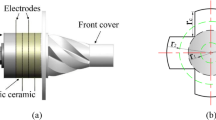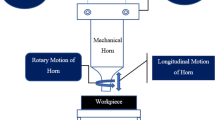Abstract
The longitudinal-torsional mode horn has gained popularity recently for ultrasonic welding (USW) because it is more efficient than a conventional longitudinal horn. Addition of slanting grooves to the front mass to achieve torsionality is not a novel approach, and few works have already addressed this issue, but comparative studies about the effect of different groove parameters such as length, depth, angle, width, and distance upon the torsionality and resonance frequency are very rare. In the present work, only one parameter was varied at a time while others were kept constant to see their effect on horn attributes, i.e., torsionality and resonance frequency. The torsionality was maximized while keeping the value of resonance frequency as close to working frequency (i.e., 20 kHz) as possible. Depth is considered to be the most important parameter since its effect on torsionality was higher than the other four parameters. Multi-layer perceptron neural network was trained using the input features (i.e., groove parameters) which has the potential of transfer learning and would ease the process of finding the optimum parameters for torsionality maximization in later projects.












Similar content being viewed by others
References
Shahid MB, Han S-C, Jun T-S, Park D-S (2019) Effect of process parameters on the joint strength in ultrasonic welding of Cu and Ni foils. Mater Manuf Process 34:1217–1224. https://doi.org/10.1080/10426914.2019.1643474
Roopa Rani M, Rudramoorthy R (2013) Computational modeling and experimental studies of the dynamic performance of ultrasonic horn profiles used in plastic welding. Ultrasonics 53:763–772. https://doi.org/10.1016/J.ULTRAS.2012.11.003
Amini S, Soleimani M, Paktinat H, Lotfi M (2017) Effect of longitudinal−torsional vibration in ultrasonic-assisted drilling. Mater Manuf Process 32:616–622. https://doi.org/10.1080/10426914.2016.1198027
Tsujino J (n.d.) Recent developments of ultrasonic welding. In: 1995 IEEE Ultrasonics Symposium. Proceedings. An International Symposium. IEEE, pp 1051–1060
Tsujino J, Ueoka T, Hasegawa K et al (1996) New methods of ultrasonic welding of metal and plastic materials. Ultrasonics 34:177–185. https://doi.org/10.1016/0041-624X(96)81780-X
Bar-Cohen Y, Sherrit S, Bao X, Chang Z (n.d.) Ultrasonic/sonic sampler and sensor platform for in-situ planetary exploration. In: Proceedings International Conference on MEMS, NANO and Smart Systems. IEEE Comput. Soc, pp 22–31
Neugebauer R, Stoll A (2004) Ultrasonic application in drilling. J Mater Process Technol 149:633–639. https://doi.org/10.1016/J.JMATPROTEC.2003.10.062
Wang J, Zhang J, Feng P et al (2018) Feasibility study of longitudinal-torsional-coupled rotary ultrasonic machining of brittle material. J Manuf Sci Eng Trans ASME:140. https://doi.org/10.1115/1.4038728
Wu C, Chen S, Cheng K et al (2019) Innovative design and analysis of a longitudinal-torsional transducer with the shared node plane applied for ultrasonic assisted milling. Proc Inst Mech Eng Part C J Mech Eng Sci 233:4128–4139. https://doi.org/10.1177/0954406218797962
Liu S, Shan X, Guo K, Xie T (2016) Design and fabrication of a skew-typed longitudinal-torsional composite ultrasonic vibrator for titanium wire drawing. IEEE Access 4:6749–6756. https://doi.org/10.1109/ACCESS.2016.2614516
Yang C, Shan X, Xie T (2015) A new piezoelectric ceramic longitudinal–torsional composite ultrasonic vibrator for wire drawing. Ceram Int 41:S625–S630. https://doi.org/10.1016/J.CERAMINT.2015.03.220
Lin S (1997) Sandwiched piezoelectric ultrasonic transducers of longitudinal-torsional compound vibrational modes. IEEE Trans Ultrason Ferroelectr Freq Control 44:1189–1197. https://doi.org/10.1109/58.656619
Lin S (1996) Study on the longitudinal-torsional composite mode exponential ultrasonic horns. Ultrasonics 34:757–762. https://doi.org/10.1016/0041-624X(96)00062-5
Al-Budairi H, Lucas M, Harkness P (2013) A design approach for longitudinal–torsional ultrasonic transducers. Sensors Actuators A Phys 198:99–106. https://doi.org/10.1016/J.SNA.2013.04.024
Al-Budairi H, Harkness P, Lucas M (2011) A strategy for delivering high torsionality in longitudinal-torsional ultrasonic devices. Appl Mech Mater 70:339–344. https://doi.org/10.4028/www.scientific.net/AMM.70.339
Al-Budairi H, Lucas M, Harkness P (2012) Optimisation of the longitudinal-torsional output of a half-wavelength Langevin transducer. 41st Annual Symposium of the Ultrasonic Industry Association, San Francisco, CA, USA pp16–18
Al-Budairi HD (2012) Design and analysis of ultrasonic horns operating in longitudinal and torsional vibration. PhD Thesis, University of Glasgow
Harkness P, Lucas M, Cardoni A (2012) Coupling and degenerating modes in longitudinal–torsional step horns. Ultrasonics 52:980–988. https://doi.org/10.1016/J.ULTRAS.2012.05.002
Shuyu L (1999) Study on the longitudinal–torsional compound transducer with slanting slots. J Acoust Soc Am 105:1643–1650. https://doi.org/10.1121/1.426717
Vakili-Tahami F, Majnoun P, Ziaei-Asl A (2019) Controlling the in-service welding parameters for T-shape steel pipes using neural network. Int J Press Vessel Pip 175:103937. https://doi.org/10.1016/J.IJPVP.2019.103937
Zhao D, Ren D, Zhao K et al (2017) Effect of welding parameters on tensile strength of ultrasonic spot welded joints of aluminum to steel – by experimentation and artificial neural network. J Manuf Process 30:63–74. https://doi.org/10.1016/J.JMAPRO.2017.08.009
Zhang Z, Wen G, Chen S (2019) Weld image deep learning-based on-line defects detection using convolutional neural networks for Al alloy in robotic arc welding. J Manuf Process 45:208–216. https://doi.org/10.1016/J.JMAPRO.2019.06.023
Wan X, Wang Y, Zhao D et al (2017) Weld quality monitoring research in small scale resistance spot welding by dynamic resistance and neural network. Measurement 99:120–127. https://doi.org/10.1016/J.MEASUREMENT.2016.12.010
Wan X, Wang Y, Zhao D, Huang Y (2017) A comparison of two types of neural network for weld quality prediction in small scale resistance spot welding. Mech Syst Signal Process 93:634–644. https://doi.org/10.1016/J.YMSSP.2017.01.028
Hocheng H, Kuo KL (2002) On-line tool wear monitoring during ultrasonic machining using tool resonance frequency. J Mater Process Technol 123:80–84. https://doi.org/10.1016/S0924-0136(02)00066-3
Fu B (2005) Piezoelectric actuator design via multiobjective optimization methods. PhD Thesis, University of Paderborn
ANSYS (2019) ANSYS_Documentation/Meshing_users’_Guide/Global_mesh_controls/Statistics_group/Mesh_metric/Skewness
Azimi M, Mirjavadi SS, Asli SA (2016) Investigation of mesh sensitivity influence to determine crack characteristic by finite element methods. J Fail Anal Prev 16:506–512. https://doi.org/10.1007/s11668-016-0117-y
Azimi M, Mirjavadi SS, Asli SA, Hamouda AMS (2017) Fracture analysis of a special cracked lap shear (CLS) specimen with utilization of virtual crack closure technique (VCCT) by finite element methods. J Fail Anal Prev 17:304–314. https://doi.org/10.1007/s11668-017-0243-1
Lee H-H (2018) Finite Element Simulations with ANSYS Workbench 19. http://myweb.ncku.edu.tw/~hhlee/Myweb_at_NCKU/ANSYS19.html
Grimes RG, Lewis JG, Simon HD (1994) A shifted block Lanczos algorithm for solving sparse symmetric generalized eigenproblems. SIAM J Matrix Anal Appl 15:228–272. https://doi.org/10.1137/s0895479888151111
ANSYS (2019) ANSYS_Documentation/Mechanical_APDL/Theory_Reference/Analysis_Tools/Eigenvalue_And_Eigen_Extraction
Géron A (2017) Hands-on machine learning with Scikit-learn and TensorFlow: concepts, tools, and techniques to build intelligent systems. https://www.oreilly.com/library/view/hands-on-machinelearning/9781491962282/
Clevert D-A, Unterthiner T, Hochreiter S (2015) Fast and accurate deep network learning by exponential linear units (ELUs). arXiv:1511.07289
Xu B, Wang N, Chen T, Li M (2015). Empirical evaluation of rectified activations in convolutional network. arXiv:1505.00853
Chollet F (2015) Keras. https://keras.io/
Pedregosa F, Varoquaux G, Gramfort A et al (2011) Scikit-learn: machine learning in python. J Mach Learn Res 12:2825–2830
Funding
This work was supported by Business for R&D funded by The Korea Ministry of SMEs and Startups in 2018 (Grant No. C06375660100486847) partially and supported by Basic science research program through the National Research Foundation (NRF) of Korea funded by the Ministry of education (Project no. 2017R1D1A1B03034483) partially.
Author information
Authors and Affiliations
Corresponding author
Additional information
Publisher’s note
Springer Nature remains neutral with regard to jurisdictional claims in published maps and institutional affiliations.
Rights and permissions
About this article
Cite this article
Shahid, M.B., Jung, JY. & Park, DS. Finite element analysis coupled artificial neural network approach to design the longitudinal-torsional mode ultrasonic welding horn. Int J Adv Manuf Technol 107, 2731–2743 (2020). https://doi.org/10.1007/s00170-020-05200-5
Received:
Accepted:
Published:
Issue Date:
DOI: https://doi.org/10.1007/s00170-020-05200-5




